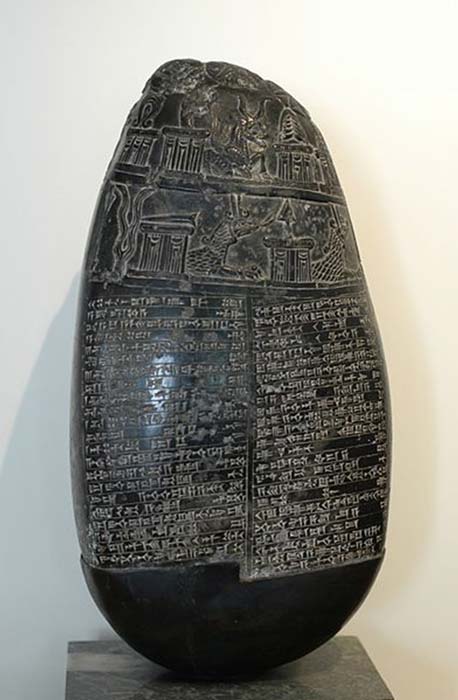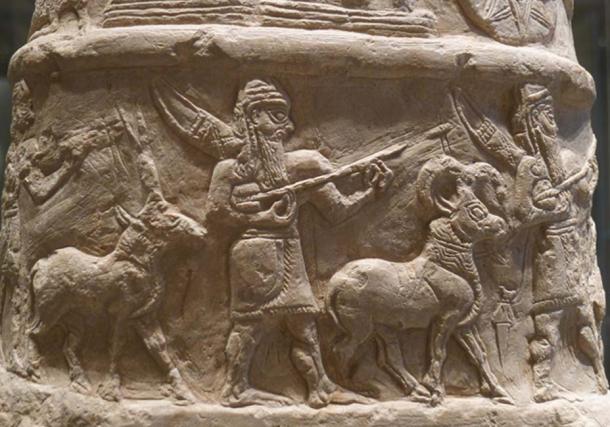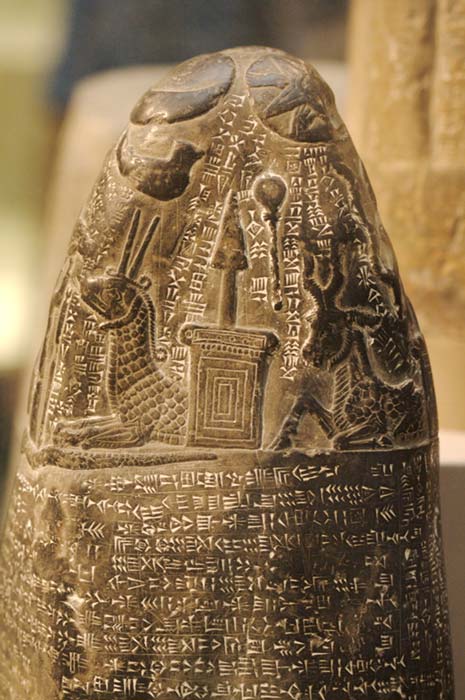Posts Tagged ‘Babylon’
Kudurru? (meaning ‘boundary’ or ‘frontier’ in Akkadian civilization). Land grants, bestowed by the king onto a person.
By Wu Mingren
While stone monuments have been used at various times in ancient Mesopotamia, it is especially associated with the Kassite period. The kudurru served as a record of gifts, especially land grants, bestowed by the king onto a person.
Today, examples of these boundary stones are exhibited in Museum.
The Origin of the Kudurru
Prior to the Kassite period (known also as the Middle Babylonian period), which lasted from around the 16 th century BC to the middle of the 12 th century BC, stone monuments like the kudurru were already being produced. These were known as narus.
It was only during the Kassite period that kudurrus began to be made. These were highly polished stone, normally limestone, slabs / blocks onto which royal grants were recorded.
The kudurru derived its name from the fact that these gifts usually took the form of land grants . Although one might imagine that the kudurru was used to physical mark the boundaries of a person’s land, this was not the case.
Instead, a kudurru would have been kept in a temple, while a clay copy of the original was given to the landowner.

Babylonian kudurru of the late Kassite period. (Rotatebot / Public Domain )
Kudurrus Were Considered Sacred
For modern scholars, kudurrus also provide some insight into the religious beliefs of the ancient Mesopotamians. Since kudurrus were kept in temples, an indication that they had some sacred value attached to them.
They were meant to be visible not only by worshippers who came to the temple, but also by the gods. The association with the divine realm is also evident in the imagery carved onto these stones.
In general, all the gods responsible for the preservation of the universe are depicted on the kudurru. The gods are arranged in rows according to their position in the divine hierarchy and are represented by their symbols.
The ordering of the gods on these boundary stones reveals to us the beliefs held by the ancient Mesopotamians regarding the organization of both the cosmos and the divine realm.

A kudurru, boundary stone, from ancient Mesopotamia. (Mbzt / CC BY-SA 3.0 )
The top row of the stone was reserved for the astral deities – the moon god, Sin, the sun god, Shamash, and the goddess of Venus, Ishtar.
The next row was occupied by the sky god, Anu, the air god, Enlil, the god of freshwater, Ea, and the earth goddess, Ninhursag.
These were important gods , as they were responsible for maintaining the equilibrium of the universe.
In some instances, there is a line separating these gods from the astral deities, while in others they are placed together.
The next three rows were occupied by the warrior gods, the gods in charge of the earth’s fertility, and the deities of the underworld respectively.
What Was the Purpose of the Kudurru?
Like the arrangement of the deities, the text inscribed on kudurrus also follows a certain order. The text may be divided roughly into 2 parts..
The first part contains the nature of the land grant, as well as the clauses attached to it, whereas the second part contains a list of curses to deter anyone from violating the agreement.
These curses called upon the gods to punish those who violated the agreement.
Thus, the land grants documented on the kudurru were not merely contracts made among human beings but also with the gods, and those who dared break them risk divine retribution.

The text on the kudurru described the land grant and conditions. (Dudubot / CC BY-SA 2.0 )
Although the Kassite period came to an end around the middle of the 12 th century, the popularity of the kudurru continued and is considered to be a legacy of this dynasty.
This is evident, for instance, in the kudurrus dating to the reign of Nebuchadnezzar I, a ruler of the Isin dynasty.
This was the dynasty that succeeded the Kassites . Kudurrus have been unearthed by archaeologists and are on display in various museums around the world today including the British Museum and the Louvre Museum.
Top image: The engraving of the gods depicted on the kudurru were arranged in a particular order. Source: Jastrow / Public Domain
By Wu Mingren
- Lost Years of Nabonidus, Last King of the Neo-Babylonian Empire
- Cursing Stones of Ireland: When Christianity and Pagans Pooled Their Sacred Water
- Nabopolassar: The Rebel Ruler of Babylonia Who Had the Gods on His Side
Note: Updated from 2019 article
Babel, Babylon: A historic site, a city, a kingdom, a “communication confuser”…?
Posted on: April 4, 2012
Babel, Babylon: A historic site, a city, a kingdom, a “communication confuser”…?
Babel is Bab Eblo in Babylonian language, which translates to Bab Eel (Door of the God) in Sumerian language and called Kad Nekrowa 6,000 years BC. Babel is situated 60 km south of Bagdad and became famous during the Akkadian Kingdom around 3,350 BC and later during Hammurabi, the king who is renowned for the first laws penalizing builders for defective constructions…
River Euphrates flowed by Babel, bu the river is very distant now from its original bed. Later, the Persian kingdom built their Capital Ctesiphon south of Bagdad and on the eastern side of the Tigres River. Babel and this region was the center of the universe for thousand of years, and Babylon was the center between 562-604 BC during the reign of Nabukhodnossor who ruled over Iraq, Syria, Lebanon, Palestine, and Egypt…Babel was rediscovered by German archeologists around 1899, particularly by Robert Coldway.
Babel northern entrance was dedicated to goddess Ishtar (goddess of fertility) and the huge door was transported to Berlin. The door was painted of 575 animal species, and the dragon (dedicated to God Marduk) had a fish body, the tail of a serpent, the front legs were a lion, and the hind legs those of an eagle.
The south castle was the heart of the city and spanned 52,000 square-meter and had 172 rooms. Each of the 5 successive esplanade, stretching from east to west, had specific function, and the south side on each esplanade had a huge community housing. The central esplanade was the Throne headquarter. The third is recorded to witness Alexander death in 323 BC and who offered sacrifices every day during his stay in Babylon. Actually, Babylon was Alexander capital for 9 years.
The Street of Victory was on the north side and 60 sculpted lions were lined on the sides. The Street was used for religious ceremonies, especially on Babylon New Year that started on April and celebrations extended for 11 days. The festivities begin at the Tower of Babel, pass through the temples, to the north area, and end at the House of Celebration (Beit Akito)
The long and vast Street of Victory was in asphalt, a tar product extracted from the Heat region in Ramadi, and scientists are still unable to reconstitute this product. Mind you that oil products, afloat in abundance in the south regions, were known at the period and the cities in Iraq were lit by oil lamps.
By the south-east side of Ishtar Door is the main temple called A-Mach (the High House). A well was in its center for the virgin girls to bath before getting wed during the New Year. Alexander offered sacrifices in this temple.
There is this famous Babel Lion of one block of basalt and weighting about 5 tons, and sitting on a base representing the various vanquished people. The rock is from north current Syria and brought via the Euphrates River.
The US military used this particular historic site as one of the major headquarter and vandalized the site and transported the precious artifacts and sold many of them. Later, the US returned a few historic pieces to the Iraqi government.
Urban and warlike civilizations
Posted on: June 16, 2010
Lions and lionesses along the Fertile Crescent ancient Empires
Major civilizations built empires and cities along major rivers such as the Nile, Euphrates, Tiger, Indus (Pakistan), Ganges (India), and the Yellow River in China.
At the current rate of modernization and deforestations most of the aborigine tribes would disappear within a few decades. Many civilizations have vanished but a few have managed to survive precariously so far.
The best approach to explaining the succession of civilizations and Empires in the Fertile Crescent that raided and conquered the Near East civilizations such as in Lebanon, Palestine and Syria (Phoenicia, Canaan, Aram) is the analogy of survival among the lions and lionesses.
As a young lion attains two years, after being chased out of the clan, prowls the region for lionesses to mate and establish clans of their own. Old lions are attacked and displaced and the cubs are eaten and slaughtered by the new King to quickly attract the lioness in heat and then new progenitors are formed. The lioness fights valiantly to preserve her cubs but ends up giving up.
Since a lion lives to be 10 years old, on average, while the lioness can outlive him by 7 years and diffuse many progenitors of her owns then the survival of these mammal carnivores is mainly due to the survival of the lionesses. The lionesses chase and bring meat to the clan and care for the cubs.
Almost all the ancient civilizations in the Middle East, (the Nile River excluded because in Africa), were established along the Fertile Crescent of the main Rivers of Litany, Al Aassi, Euphrates and the Tiger (for example, the people inhabiting Lebanon, Syria, the southern part of Turkey, the Western part of Iran and Iraq).
The warrior Empires were Akkad, Babylon (Iraq), Assyria (Kurdestan of Iraq), Persia, Pharaonic Egypt, Hittite (Inland Turkey), Greece, Selucian, Roman, and later Byzantium, Sassanide, Arab (Umayyad, Abbasid, Fatemid), Seljuk, Crusaders, Mamelouks, and Ottomans.
The young male lions from emerging warrior Empires, during their conquests and expansion, reclaimed the civilized glory and achievements of the Near East people as their own proper. The Near East people were constantly behaving like the lionesses: they first fight valiantly for their cubs, and when they inevitably fail against the young lions then they mate with the conquerors after the invaders had tried to kill all their progenitors.
The latest archeological discoveries located developed urban centers around the borders of Syria and Turkey that were 10,000 years old; it is these centers that later established the Sumer Kingdom in southern Iraq around 5,000 years ago.
A few citizens of City-States like Byblos, Sidon and Tyr and much later Carthage burned down their cities and then set fire on themselves to avoid servitude and surrender. While these young lions were strutting and showing off in the regions and adapting to the new civilizations, it was the constant duty of the lionesses to chase and bring the meat to the table and care for the household: They fed and civilized the conquerors.
The Near East people were bringing the food to the tables and caring for the glamour and wants of the invaders whose sole job was to making war and killing on their war paths.
I read chapters from an Arabic book by Georges Masrou3a. Masrouaa asked an archeologist about the Achmoun Temple in Sidon “Saida”, built around 550 BC and he replied that it was a Persian design from King Kourush I period.
Masrouaa then asked the archeologist why he claimed that it is Persian and the latter said because that is what the archeology archives claim to be. Persia had no such Temple at Kourush’s time; even if the Persian King paid for it at the expense of the invaded people that should not be a basis to claim achievements of other civilizations.
This is the same story with the temples in Baalbak; the archeologists would claim that it was the work of the Romans since 200 BC but if this monument was of Roman style and glory then why the Romans failed to build something close to it in Rome or in Italy?
We have the same contentions for the impressive horse track and humongous amphitheater in Tyr (500 by 200 meters) that was built before 500 BC according to Herodotus; if this amphitheater was the work and style of the Romans then why did the Roman wait another three centuries to build their Coliseum? The same goes to the Jerusalem Temple even though the architects, builders and foramens and craftsmen and master workers were from Tyre during King Hiram or “Ahiram”.
Euclid, Zenon, Plotin, Tales, Homer, Pythagoras and scores of great thinkers were born and lived in our coastal City-States stretching from Palestine to Turkey such as Akka, Tyr, Sidon (called the eldest son of Canaan in the Bible), Beyrouth, Byblos, Ugarit, Antaqia, and so on and yet they were labeled as Greeks. Is it simply because we were under Greek dominion that our famous thinkers should be Greeks, even if they didn’t enjoy the privileges of Greek Athens City-State citizens?
Scores of our famous people were labeled Romans simply because we were under Roman hegemony. For example, the eminent legal masters, in the third century, Papinian and Olypian lived in Beyrouth (Beryt); Olympian is indeed the martyr of jurists because he adamantly refused to offer a legal opinion in favor of Emperor Caracala for the killing of his brother Jeita.
If this is the case then, why Jesus is to be simply a Jew and not Roman? St. Paul was actually a Roman citizen that he inherited from his father and great father and yet Paul is said to be simply a Jew. There is undoubtedly a systematic disinformation concerning the cultural heritage of the Near Eastern civilizations.
The Europeans purposely have chosen to start their civilization from Ancient Greek in 600 BC because they claimed Athens City-State to be democratic and they had to emulate the democratic system in Greek Athens.
Democracy was developed in the City-States of Byblos, Sidon, Tyr, Ugarit and Mary several centuries before Athens existed. These City-States had democracy within their city limits as Athens and Rome emulated later on because communication and transport were limited and the administration of such a complex democratic system was not feasible at a larger magnitude at the time. Thus, democracy was not translated to the colonies as Greek Athens also failed to do.
Theaters via their verbal communications in plays were the main medium for spreading democracy and the clashing of ideas of various opposition groups; plays created a citizen consciousness that is different from immediate civic consciousness of oratorical speeches. The Near Eastern civilizations were ahead of Athens several centuries in theater plays; Athens got the attention because a few of its written literatures were preserved and translated. For example, Aeschylus wrote over 90 works but only seven of his tragedies remained to prove the dynamics of Athens’ democratic system.
Although the City-States in the Levant developed commercial empires they never built theocratic warrior Empires because their citizens focused on civilized endeavors and opted in armed struggles to just defending their central Cities. Athens managed to defend its civilization outside its City limits and even asked the cooperation of other Greek City-States like Sparta and the famous Thebes that the Phoenicians had built centuries before Athens existed and which Alexander erased completely before launching his Asian campaign.
We can confirm that the Near East region was the bedrock of all the civilizations around the Mediterranean Sea in religion, philosophy, sciences, literature and arts.
Regardless of genetic sources, which are an amalgamation of many nations and which is not that important for the purpose of this article, anyone from current States in the Near East should take pride in their ancient civilizations and their original identity as the forefathers of contemporary modern democratic civilizations in Europe and the Greater Mediterranean Sea regions.
Note: Currently, we still have the ethnic Saamis (Norway and Finland), Inuits (Siberia, Alaska, and Canada), Ainous (Japan), Indians (USA and Canada), Zapotec (Mexico), Mosquitos (Nicaragua), Quiches (Guatemala), Cunas (Panama), Yanomamis and Guaranis (Brazil), Galibis and Akawaios (Guyana), Paez ans Guambianos (Colombia), Waoranis (Equator), Amueshas (Peru), Chimanes (Bolivia), Araucans (Chili), Touaregs and Bororos (Sahel in Northern Africa), Tigres (Ethiopia and Somalia), Dinkas (Sudan), Masais (Kenya and Tanzania), Pygmees (Zaire), Sans or Bushmen (Namibia and Botswana), Kalingas (Philippines), Kachins and Rohingas (Myanmar or Birmani), Hmongs (Laos), Santals and Gonds (India), Punans (Malaysia), Uzbeks and Tadjiks (Afghanistan), Aborigines (Australia), Maoris (New Zealand), Papous (New Guinea).

